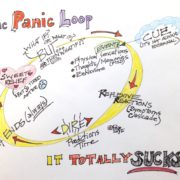I work with people who just can’t stop worrying. They tell me about the awful panic attacks they have, which can feel devastating. Many show up in the emergency room, only to be told there is nothing wrong. Being stuck in the panic loop stinks, but you can learn how to manage it so it doesn’t take over your life. The body doesn’t lie; when it shouts, you have to listen—but maybe in a whole new way.

How To Manage A Panic Attack
You must learn how to have a new relationship with your anxiety—the kind where you are the boss! The hardest thing to get your head around is that those “worry thoughts” aren’t real. They just masquerade as such.
The dread of having a panic attack is a well worn, deeply embedded habit. It is seated in your brain’s amygdala, and forms a superhighway to panic as the ‘go-to’ emotion that you no longer even question.
Learning to question anxiety is a significant goal you must embrace.
This takes dedication and commitment on your part because it is hard to go through the fear! But if you suffer with this, please know that you can tame it. You can’t strengthen muscle without adding greater weight, just as anxiety cannot be managed without challenging it to build your emotional resilience.
We’ll Create A Personalized Panic Attack Protocol
What is that you say? Everyone responds a little differently to panic both physically and in what they need when it is happening. Most will feel their heart racing, some get very hot, some experience feeling very cold. Many get very thirsty, especially if they get hot. Some don’t want to be touched at all, not even a friendly pat on the back. And some will feel soothes with very gently back rubbing. Most will need quiet. And all are exhausted and need rest after it ends. But understanding what YOU need is key. Then we educate.
Then We Educate About YOUR Panic Attacks
In session, we will both figure out how to distill your personal panic attack protocol down to notecard size, and you may choose to educate a partner, family member, or close friend about how this works. You do that when you’re calm and at ease so it becomes simply an informational conversation with them with the purpose of teaching them how to best respond when you have an attack.
Then when it occurs, everyone knows exactly what is happening and what to do to best help you through it. One of the upshots of doing this is people tell me their attacks are less frequent, less intense, and are over more quickly. Wow. When you have severe panic disorder, that is a worthwhile goal to achieve. No more ending up in the emergency room thinking you are having a heart attack. Or worse, because you are incapacitated for a time, someone else is deciding what you need when it is not.
A Final Word On Panic Attacks
Anxiety is our early warning system. We don’t want to get rid of it. It keeps us alive. But, you must learn how to better manage it. Creating and implementing a panic protocol is one way to do this. I can help you figure this out. Call or contact me, or hop online and schedule your first appointment.










 Page Rutledge, LCSW
Page Rutledge, LCSW